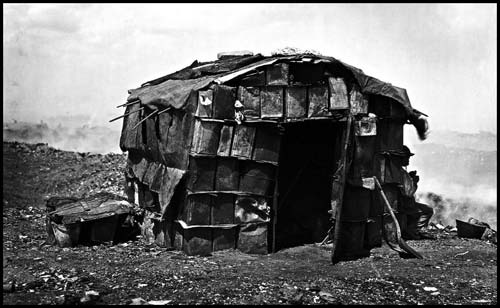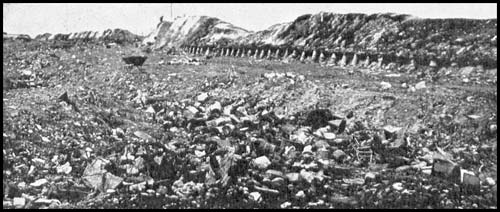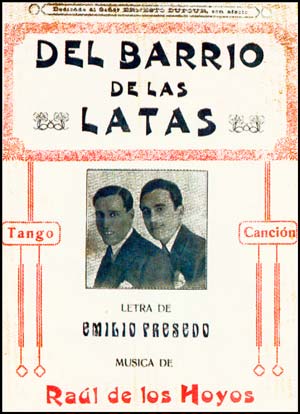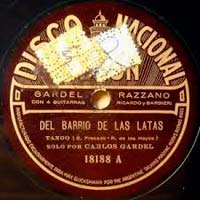By
El Barrio de las Latas, legends about tangos and sainetes

ome, may have heard about its existence and it was all right for them that, there, at a far distant place, would be a garbage landfill. Others, far from these worries, would be witnessing the complicated events of the time, the struggle of political differences, ones with Nicolás Avellaneda and others, with Carlos Tejedor.
There was lack of jobs, immigration forced the building of more tenement houses, a dreadful port almost inexistent began to be active when, by 1855, the new Customs office of the British Edward Taylor was built. Horse-drawn wagons with big wheels went into the river waters to get the passengers who switched from one means of transport to another and, from there, to the wide quay. We were in the second half of the nineteenth century and tango was just under development.

It was not a problem for the authorities what happened on those wastelands which were around the poor brick buildings and tried to be assembled to become a neighborhood. For many years, very few knew about its existence, well-to-do people had no trouble with material needs. The plague had not yet arrived with its deadly fever. But finally it appeared, it was by 1871, and then those wealthy people fled towards the northern riverbank, to build a new and safer settlement.
Timidly, the first streetcar appeared in 1863, rather as an attempt than as solution for transportation in the neighborhood. Then in 1870, the Lacroze brothers with their horse-drawn vehicles covered a 47-kilometer area which soon was enlarged. Then the dwellers of the lower classes found in it a suitable means of transport. In the 90’s the electric streetcar arrived.
We do not know when the big garbage dump began, but we do know, that President Domingo Faustino Sarmiento signed a decree in 1871, which authorized a municipal landfill (Vaciadero Municipal) which encompassed an area of over thirty blocks and about two meters high. The area was known as Matadero y Corrales del Alto, where animals were slaughtered on the mud and dirt. Later, Matadero del Sur and, after November 11, 1872, was officially named Corrales Viejos, located to the southwest of the future Capital Federal.

This name only lasted thirty years. After 1902 it was definitively called Parque Patricios. However, Corrales Viejos, according to lunfardo poems, was the place where tango was born.
Miguel Andrés Camino (Buenos Aires 1877- 1944) in a long poem said in its first stanzas:
Nació en los Corrales Viejos, allá por el año ochenta./ Hijo fue de una milonga y un pesao del arrabal./ Lo apadrinó la corneta del mayoral del tranvía,/ y los duelos a cuchillo le enseñaron a bailar.
And Francisco García Jiménez in “Juè un domingo en los corrales”:
Salieron los bailarines por valses, mazurca y polca
y entremedio, una pareja salió bailando otra cosa.
Con cortes y quebradas firmaban en el suelo.
No lo hacían de compadres pero compadreaban sin güelta.
Al final bailaron solos pa’ contentar a la rueda.
Bailaron una mestura que no era pa’maturrangos,
de habanera con candombe, de milonga con fandango.
Jué un domingo en los Corrales cuando inventaron el tango.
The La Prensa jornal, on May 9, 1903 informed about the subject and mentioned the location of the big piece of land, an important portion of the Alcorta avenue, where in 1947, the soccer stadium of the Club Huracán would be opened. There, on the same waste material of a whole city, a large number of people settled in what turned out into the first «villa de emergencia» (shanty town). The lowest and vilest class of our society worked and lived on that dirt.
In 1866 a so-called garbage train began to circulate which, with its full containers, left from the 11 de Septiembre station and, daily, unloaded its contents at the place. Thereafter, municipal carts did this task, and were recognized because were painted in red. The Caras y Caretas magazine, on January 21, 1899 published a note in which they state that until midday, a thousand wagons unloaded garbage. This landfill was popularly called Barrio de las Latas or, in a more pejorative way, La Quema, alluding to the fact that the garbage was burnt. It was called «De las Latas», because most of the houses, of small dimensions, were built with oil or kerosene cans which were filled with mud. They were built on a foreland at a height of at least two meters, to prevent the entry of water, because the whole area had large puddles and even ponds, where there were many frogs. Because of that feature, it was also called, Barrio de las Ranas or Pueblo de las Ranas.

Curiously, the idea that those dwellers were cunning, shrewd, and fast to understand began to spread. From this opinion came the adjective rana to describe a smart, fast, naughty person. This thinking about these kind of people was spreading and, now in the downtown areas, for years, an individual praised another by describing him as a rana guy.
As soon as the garbage arrived, it was burnt and, with great skill, when the embers were very hot, the dwellers caught the things of some value: bottles, flasks, metal sheets, nearly everything they could sell. With patience and skill they took advantage of the smallest thing which meant for them a profit. Due to that ability they were called «los cirujanos» (the surgeons) and hence its short form, which remains from that time, to qualify displaced people in a degrading way: cirujas.
In 1912 its final stage began. The municipality was cornering each slum and the wagons then had to carry their remains. The little tin houses disappeared. By 1920 the garbage dump had disappeared and a habitable neighborhood began to appear which was occupied by hundreds of workers. But testimonies remained written by theater playwrights and by tango people. The theater style known as género chico was which most made use of the subject. Among the many plays, one that stood out was En el Barrio de las Ranas, by the playwright from Rosario, Enrique García Velloso (1881 - 1938). It had four acts and was presented at the Teatro Apolo by the Vittone-Pomar company in 1910.
 Almost at the same time, Del mismo barro, by Pedro Eugenio Pico (1882- 1945). In 1912 the Alberto Novión’s sainete Los Chimangos was premiered, the following year, La chusma and in 1917, El rincón de los Caranchos.
Almost at the same time, Del mismo barro, by Pedro Eugenio Pico (1882- 1945). In 1912 the Alberto Novión’s sainete Los Chimangos was premiered, the following year, La chusma and in 1917, El rincón de los Caranchos.
In 1918 Alberto Vaccarezza staged La otra noche en los Corrales and Juan Andrés Caruso El Tigre de los Corrales. A journalist of that time was right when he said: «La Quema was a corner that gave rise to a profuse theatrical literature.» And also in tango, as we can find in the lyrics of tangos and some milongas, like the landmark case of “El ciruja”, premiered by the singer Pablo Gómez and which, since then has had, numerous renditions, among others, the one by Gardel, in 1926 and the one by Julio Martel with the Alfredo De Angelis orchestra, in 1949.
“Del barrio de las latas” was also recorded by Gardel in November 1926. The same tango was committed to record, in 1953, by the Carlos Di Sarli orchestra with Mario Pomar on vocals (a curious thing: the true Pomar’s surname was Corrales). As an instrumental, Aníbal Troilo recorded it with his Nuevo Cuarteto, in 1968, without Roberto Grela and Edmundo Zaldívar, but with Ubaldo De Lío, Osvaldo Berlingieri and Rafael del Bagno.
The milonga “Un bailongo”, recorded by Gardel in 1922. “A mí no me hablen de tango”, several times committed to disc, among others by Tita Merello with Carlos Figari and Troilo with Roberto Goyeneche.
 The tango, “Juana Rebenque”, recorded by the Francisco Canaro orchestra, with Guillermo Rico on vocals, in 1946. Some colleagues say that this woman existed and lived in La Quema, such is the case of Oscar Himschoot and Luis Alposta who say that she was a dancer:
The tango, “Juana Rebenque”, recorded by the Francisco Canaro orchestra, with Guillermo Rico on vocals, in 1946. Some colleagues say that this woman existed and lived in La Quema, such is the case of Oscar Himschoot and Luis Alposta who say that she was a dancer:
«Juan Santa Cruz —brother of Domingo Santa Cruz, the composer of “Unión Cívica”— (quotation by Dr. León Benarós): «Juana Rebenque lived in a low tin little house, like all in the Pueblo de las Ranas. You had to bend to be able to get in. She not even had a tariff. She collected what you liked to give her. She never came downtown. She was tall, slim, with a big nose, but good looking. She lived with someone named Fernández. She was mentioned in some stanzas in vogue at that time: Hará cosa ‘e una semana que un canfinflero mistongo/ me convidó pa’ un bailongo en el Pueblo de las Ranas./ Las principales bacanas de la ranil población/ cayeron a la función lindamente enfaroladas,/ porque habían sido invitadas con tarjetas de cartón».
To conclude with pieces that allude to the place, two milongas, “Corrales Viejos” and “Parque Patricios”, both by Anselmo Aieta, Francisco Laino and Antonio Radicci, that Francisco Canaro with Ernesto Fama, in 1940 and Francisco Lomuto with Fernando Díaz, in 1941, recorded respectively.
Finally, some meanings derived from the word «rana».
As it was said above: clever, naughty, cunning person. Examples: the tango “El bulín de la calle Ayacucho” when it says, «que en mis tiempos de rana alquilaba…» or in the text by Evaristo Carriego «échele la culpa al rana, que me espiantó la cartera…» or in “Consejos reos”, «Yo conozco muchos ranas que se han casado después».
«Ranero/a» was called the one who lived at that «población o barrio de las latas» (garbage dump) and, by extension, tough guys, rogues or vagabonds. (Félix Lima 1880-1943, journalist and writer). Also those who have love affairs with dirty vagabond women. A shabby tenement house dweller who lacks any kind of shame (Comisario General (R) Adolfo Enrique Rodrìguez). Another definition: Poor, humble, miserable, from the underground. (Fernando Hugo Casullo).
Ranita: boy who looked after the horses which drew wagons when they were set loose. In the dialect of Milan, ranín means little kid. (José Gobello)